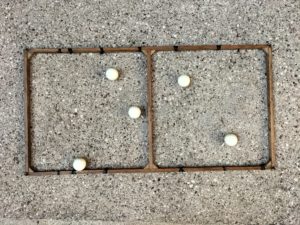Teaching activity planned by Deimer Antonio Alvarez Garay, Alex Ciabattoni, Camilla Giusti ans Elena Tomasetti during the PhD course “Designing innovative public engagement activities”, held at the University of Bologna in 2023.
We recognize familiar figures in constellations because of our culture and habits; each people has seen in constellations different objects and characters according to their own roots. Those figures are really the fruit of the only perspective which we have of them from the Earth. If we could look at them from a totally different region of space, we would see that those same stars form completely different viewpoints…
Materials
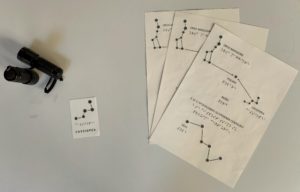
- 5 polystyrene spheres. In case, the spheres can be painted with a glow-in-the-dark paint, if you want to lead the activity in the dark
- fishing line or twine
- gazebo or another structure which allows to hang the Styrofoam spheres
- maps of the Cassiopeia constellation. If you want to create a multi-sensory lab, maps can be made tactile and/or printed upon microcapsule paper (link)
- audio file nr. 1: link
- audio file nr. 2: link
- audio player (smartphone, speaker, computer, …)
Description of the activity
PREPARATION:
Prepare a structure (gazebo or even twine stretched between two walls or supports) on which you can hang 5 polystyrene spheres, which represent the 5 stars of the Cassiopeia constellation. The spheres are placed so as to form a W, namely, the shape Cassiopeia assumes as seen from the Earth. The spheres should be able to move vertically, so that they can be lowered and raised. The length of the wire to which the spheres are hung is proportional to the distance of the star from the Earth (see the table in the section “Description of the physical process”).
If it is not possible to build a support for the 5 polystyrene spheres, such as the one shown in the figure, we can choose the following alternatives:
- twine (or another support) suspended between two walls with pins
- a few participants hold in their hands the heads of the string which holds the balls, while their schoolmates carry out the activity
- instead of asking the participants to sit underneath the structure holding the balls, the activity can be carried out by building a constellation tube (see the instructions for the construction: link). As an alternative, you can string the polystyrene balls on sticks of a height proportional to the distance of the stars from the Earth (see the table in the section “Description of the physical process”). Thrust the sticks on a support (for example in a sponge, in the ground, in the sand, …) so that they stay vertical. In this way, participants will be able to place the constellation on the ground and observe it from above, or place the constellation upon a table and observe).
CARRYING OUT THE ACTIVITY:
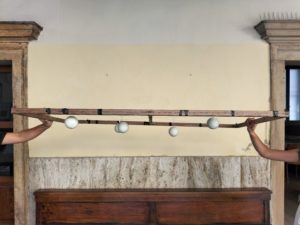
Participants sit or lay under the gazebo. The 5 polystyrene balls representing the stars of Cassiopeia all hang at the same height (Figure 1). All participants receive a printed map of Cassiopeia. Engage the participants with a few questions introducing the context, for example: what do you usually see in the night sky? Do you know what constellations are?
Ask them to imagine that they are sitting under a starry sky. Above them, there are 5 polystyrene spheres, which represent the stars of the Cassiopeia constellation, the constellation at the top of the map. Ask participants to observe the hanging spheres and/or the map they are holding in their hands and tell them about the shaper of the Cassiopeia constellation. M, W, or zig-zag…there is no single correct answer. Tell them that just as they think that stars see to represent different shapes, also different peoples of the Earth have seen different images. Tell them some of the stories which different peoples have created.
The Greeks used to see in these 5 stars a beautiful queen, sitting on a throne trying to comb her long hair. This was the Queen of Ethiopia, Cassiopeia. Cassiopeia was a very vain woman, who said she was beautiful, even more beautiful than the goddesses of the Olympus. This made Amphitrite, wife of Poseidon, god of the sea, very angry. Poseidon, in order to punish Cassiopeia for her vanitay, decided to hang her in the sky. But that’s not all: he made Cassiopeia hang upside down for 6 months and right-side up for 6 months. Indeed, if you observe the sky during the year, you will see Cassiopeia either as a M, or upside down, like a W, because of the Earth’s rotation. Ask participants whether they they can retrace the image of the queen.
For the Navaho instead, a native american people, this constellation was called Biàd. Biàd too was a woman, the first woman ever existed. They saw her in the sky next to her husband Bika, which we call Big Dipper. Between Biàd and Bika we can only find the North star, in which Navaho used to see a hearth.
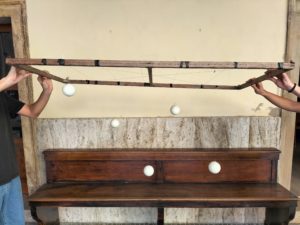
Ask participant what these stories tell us. The various populations who looked at the sky often recognized similar shapes in the sky, but interpreted them in a different way, according to their culture, their religion and their habits. Make them also notice another aspect: the 5 spheres representing the 5 stars of Cassiopeia (or Biàd), all hang at the same height. If we wanted to represent them with a sound, we might imagine 5 different musical instruments all playing at the same volume. Let them listen to audio track 1 (link).
Ask participants whether they think that the 5 stars of Cassiopeia are all at the same distance from us. After listening to ther reflections, tell them that the astronomers who studied them, discovered that those 5 stars, which look like 5 points drawn on a sheet of paper, actually are 5 objects placed farther or nearer to us. However, since they are all very far from us, it is difficult to see this difference with our own eyes. We cannot get close to these stars to see this difference; even a powerful spaceship would not be enough. However, this difference can be imagined. Now unhook the spheres from the ceiling, letting each ball hang from a rope (Figure 2). These ropes have different lengths to represent, in scale, the right distance one from the other. Now let them listen to the audio track 2 (link). The volume of sounds has changed according to the distance of the star from us (nearer stars have stronger sounds, whereas father stars have weaker sounds).
Ask participants to comment on what has happened. You can guide the answers by asking them to observe the spheres (now are they all on the same plane, or else are placed at different distances? And earlier?) and/or comparing the sound traces (the volume of various instruments has changed: which star is represented by the violin? Which from the piano?).
Now ask them to imagine what is going to happen if, instead of sitting under the stars, they stand up and lay on one side. What shape do the stars have? An M or a W, or yet another shape? Have participants move to check whether their assumptions are correct. Cassiopeia, like all constellations, has the shape we see, as inhabitants of the Earth. If we went to another planet, in another part of the Universe, probably the same 5 stars would form a different design, as it happened when passing from laying under the spheres to standing beside them. For example, if we moved on the nearest star, Proxima Centauri, and looked once again at the stars forming Cassiopeia, we would see a similar shape, with one more star. Show the representation in the lower part of the map: the Sun is the leftmost dot. This happens because from that point of view our Sun would be much nearer to the 5 stars of our Cassiopeia. It is therefore probable that, if there is a civilization on Proxima Centauri which loves stars and constellations like us, they will have invented a story on a constellation made of 6 stars, of which one is just our Sun!
Explanation of the physical process

Cassiopeia is a constellation made of 5 stars, which are called alpha Cassiopeiae, beta Cassiopeiae, gamma Cassiopeiae, delta Cassiopeiae and epsilon Cassiopeiae (molto fancifully, stars A,B,C,D, and E of Cassiopeia).
DISTANCE: the distance is given in light years. One light year is the distance travelled by light in one year, at a speed of about 300’000 km/s.
1 light year = 9’500 billions km
RADIUS: The radius is expressed in solar rays, where a solar ray is a Sun’s ray which corresponds to about 700’000 km.
MASS: even the mass is referred to the Sun, therefore the values in the table are expressed in solar masses, where one solar mass is equivalent to 2 × 10^30 ?? .
COLOR: the color of the stars gives us information on their temperature.
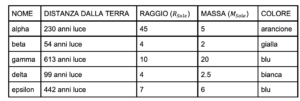
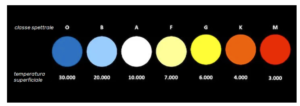
When can we see Cassiopeia in the sky?
Practically all the time. Cassiopeia is very near to the North Star, the only star which remains fixed in the sky because it is placed along the Earth’s axis of rotation. All constellations, therefore, rotate around the North Star. The nearest ones (circumpolar constellations) like Cassiopeia, Ursa Minor or Ursa Major, near enough never to gown down below the horizon, and thus always visible.

Why do we see Cassiopeia 6 months upside down and 6 months up?
Cassiopea can be found in the sky all the year long, for the motives above; it makes everyday a lap around the North Star in 24 hours. Out of these 24 hours, we can only observe it for about half, ie for the duration of the night. Therefore, in the same day, we will see it mostly upside down or up. Moreover, the Earth also rotates around the Sun (revolution), and this, together with the changing seasons, also changes the “slice” of visible nocturnal sky (indeed, most constellations are only visible for half a year). On Cassiopeia this effect only modifies the moment in which we can see it during its rotation. As a consequence, this allows us to see it for 6 months more like an M and for 6 months more similar to a W.
Why if we move on Proxima Centauri the constellation does not change much its shape?
Because Proxima Centauri is much nearer to us (4 light years) in relation to the stars of the constellation of Cassiopeia (the nearest one is 54 light years away). Imagine a goalkeeper in a football field, looking at the enemy’s goal. No matter if he looks at it from one post, or the other of his net, he will see the enemy’s goal net more or less always in the same way.
How can we see the Sun together with Cassiopeia if we move on Proxima Centauri?
Imagine you are on the Earth, looking at Cassiopeia. If you take a 4 light-year backflip, still looking at Cassiopeia, you will land on Proxima Centauri. At that point, right in front of you, you will have all the stars of Cassiopeia, the Earth and the Sun (which will be very near to the Earth). However, since the Earth is extremely small in comparison with the Sun and does not shine with its own light, you would only see the Sun.
Earth radius = about 6500 km
Sun radius = about 700’000 km
Earth-Sun distance = 150’000’000 km
If you want to learn more about the myth tied to the constellation: link

